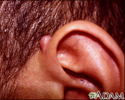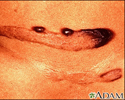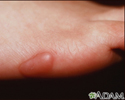Keloids
Keloid scar; Scar - keloid
A keloid is a growth of extra scar tissue. It occurs where the skin has healed after an injury.
Causes
Keloids can form after skin injuries from:
- Acne
- Burns
- Chickenpox
- Ear or body piercing
- Minor scratches
- Cuts from surgery or trauma
- Vaccination sites
Keloids are most common in people younger than 30. Black people, Asians, and Hispanics are more prone to developing keloids. Keloids often run in families. Sometimes, a person may not recall what injury caused a keloid to form.
Symptoms
A keloid may be:
- Flesh-colored, red, or pink
- Located over the site of a wound or injury
- Lumpy or ridged
- Tender and itchy
- Irritated from friction such as rubbing on clothing
A keloid will tan darker than the skin around it if exposed to the sun during the first year after it forms. The darker color may not go away.
Exams and Tests
Your doctor will look at your skin to see if you have a keloid. A skin biopsy may be done to rule out other types of skin growths (tumors).
Treatment
Keloids often do not need treatment. If the keloid bothers you, discuss your concern with a skin doctor (dermatologist). The doctor may recommend these treatments to reduce the size of the keloid:
- Corticosteroid injections
- Freezing (cryotherapy)
- Laser treatments
- Radiation
- Surgical removal
- Silicone gel or patches
These treatments, especially surgery, sometimes cause the keloid scar to become larger.
Outlook (Prognosis)
Keloids usually are not harmful to your health, but they may affect how you look.
When to Contact a Medical Professional
Contact your health care provider if:
- You develop keloids and want to have them removed or reduced
- You develop new symptoms
Prevention
When you are in the sun:
- Cover a keloid that is forming with a patch or adhesive bandage.
- Use sunblock.
Continue to follow these steps for at least 6 months after injury or surgery for adults. Children may need up to 18 months of prevention.
Imiquimod cream may help prevent keloids from forming after surgery. The cream may also prevent keloids from returning after they are removed.
References
Dinulos JGH. Benign skin tumors. In: Dinulos JGH, ed. Habif's Clinical Dermatology. 7th ed. Philadelphia, PA: Elsevier; 2021:chap 20.
Patterson JW. Disorders of collagen. In: Patterson JW, ed. Weedon's Skin Pathology. 5th ed. Philadelphia, PA: Elsevier; 2021:chap 12.
Keloid above the ear - illustration
Keloid above the ear
illustration
Keloid - pigmented - illustration
Keloid - pigmented
illustration
Keloid - on the foot - illustration
Keloid - on the foot
illustration
Review Date: 11/18/2022
Reviewed By: Elika Hoss, MD, Assistant Professor of Dermatology, Mayo Clinic, Scottsdale, AZ. Also reviewed by David C. Dugdale, MD, Medical Director, Brenda Conaway, Editorial Director, and the A.D.A.M. Editorial team.







